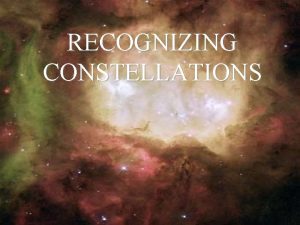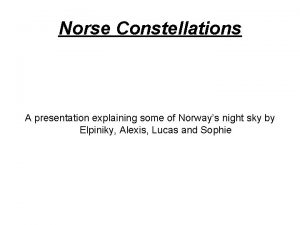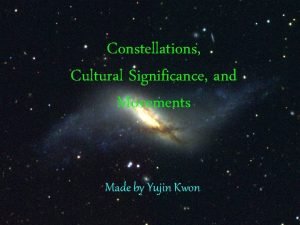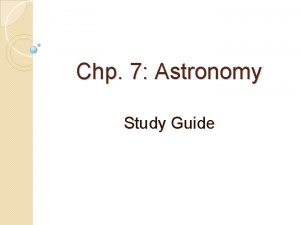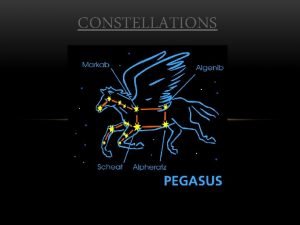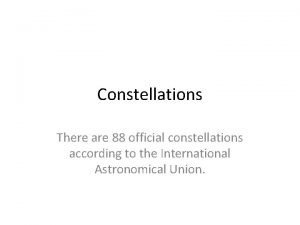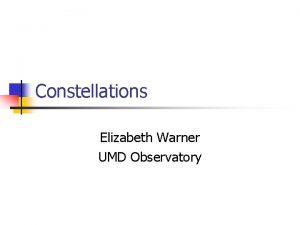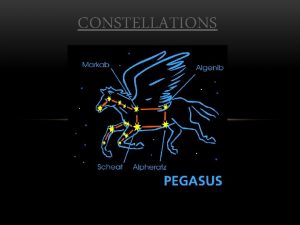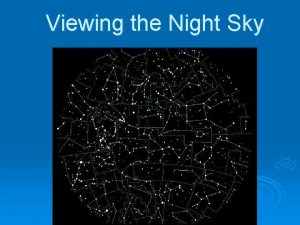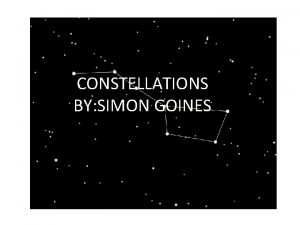Chp 7 Astronomy Study Guide Constellations Patterns of






















- Slides: 22

Chp. 7: Astronomy Study Guide

Constellations �Patterns of stars in the sky. �Ex. The Big Dipper

Astronomical Unit �Used to measure distances within our solar system. �Ex. The distance between Earth and the Sun

Light-Year �Used to measure large distances in our galaxy and universe. �Measured as the distance light travels in 1 year.

Apparent Magnitude �The measure of the amount of light or brightest of an object in space from here on Earth. �Ex. The apparent magnitude of our Sun is brighter than the star Sirius when looking at them from Earth.

Absolute Magnitude or Luminosity �The measure of the true brightness of light given off by an object in space. �Ex. The true brightness of Sirius is much brighter than the Sun.

Parallax � The apparent shift in position when viewed from two points. � This is another way to measure distances of objects in space. � Uses trigonometry and formulas to measure distances.

Electromagnetic Spectrum � The ES shows wavelengths of various waves ranging from radio to gamma rays. � The spectrum starts with longer, less frequent wavelength with low energy, and ends with shorter, high frequency wavelength with high energy. � Ex. As the wavelength of light increases, then it’s energy also increases.

Doppler Shift �The Doppler Shift is the shift of different wave lengths of light based on whether an object in space is moving towards you or away from you. �As light from an object moves away from you, its wavelength stretches out and shifts to the red end of the visual light portion of the Electromagnetic Spectrum. �The more distant a galaxy is, the faster it moves away from Earth, and is more redshifted.

Characteristics of the Sun �Sunspots are cooler areas on the Sun’s surface. �Solar Wind occurs when charged particles stream away from the sun. �Solar Flares are sudden increases in brightness of parts of the Sun that can last for minutes to hours.

Color and Temperature of Stars �The coolest stars in space are red. �The hottest stars in space are blue. �The order of the color of stars in regards to temperature from hottest to coolest are blue, yellow, orange, red.

Binary Star Systems �The most common star system where two stars orbit each other. �Astronomers can determine a star’s mass by studying binary star orbits. �The Sun is not in a binary system because the next closest star is 4. 2 light-years away.

Hertzsprung-Russell Diagram �A graph that plots luminosity (brightness) on the y-axis and temperature on the x-axis. � Most stars fall within the Main Sequence running diagonal on the graph. Our Sun is in the middle of the Main Sequence. � Super giants are very bright but cooler stars, while white dwarfs are not as bright but much hotter. � Also, the x-axis (temperature) is backwards compared to most graphs. It starts with the hottest temperatures and goes down to the cooler temperatures.

Hertzsprung-Russell Diagram Cont.

Star Cycle �All stars form in a large cloud of gas and dust called a nebula. After this the cycle changes based on the mass of the star. A massive star will begin as a Protostar after the nebula. �At the end of an average star’s life it becomes a planetary nebulae and condenses into a white dwarf. �At the end of a massive star’s life it becomes a supernova and either becomes a neutron star or a black hole based on how the supernova explodes/implodes.

Star Cycle Cont.

Black Holes �A region in space that is so dense that nothing, including light, can escape its gravity field.

Galaxies �Galaxies are groups of stars, gas, and dust held together by gravity. �There are 3 kind of galaxies: spiral, elliptical, and irregular.

Spiral Galaxy �A black hole is located at the center of spiral galaxies. �Earth is located in the disc of the Milky Way galaxy. The Milky Way is a spiral galaxy. �The Milky Way is part of a cluster of galaxies called a local group. It’s also 100, 000 light-years across and has about 200 billion stars.

Elliptical Galaxy �Elliptical galaxies are similar to a football shape. �These galaxies usually have a higher number of old red stars. �They also contain little or no gas and dust.

Irregular Galaxy �Irregular galaxies are oddly shaped. �Many form from the gravitational pull of a nearby galaxy. �They also contain many young stars.

Big Bang Theory �The Big Bang Theory states that between 15 and 20 billion years ago, the universe began expanding out of an enormous explosion.
 Learning astronomy by doing astronomy activity 1 answers
Learning astronomy by doing astronomy activity 1 answers Learning astronomy by doing astronomy
Learning astronomy by doing astronomy Learning astronomy by doing astronomy
Learning astronomy by doing astronomy Big idea 7
Big idea 7 Patterns of power study guide
Patterns of power study guide Chp bit inspection
Chp bit inspection Hardvarf
Hardvarf Market research igcse
Market research igcse Opt model phases
Opt model phases What are the 5 major discourses in matthew
What are the 5 major discourses in matthew Which chisel shape is used when removing damaged rivets
Which chisel shape is used when removing damaged rivets Mission statement keywords
Mission statement keywords Double ended queue
Double ended queue Chp 14
Chp 14 Chp dre
Chp dre Seleccion disruptiva
Seleccion disruptiva Community housing partners christiansburg va
Community housing partners christiansburg va What constellations can you see all year round
What constellations can you see all year round Thiazi's eyes constellation
Thiazi's eyes constellation Les constellations les plus connues
Les constellations les plus connues Yujin constellations
Yujin constellations Cepheus horse
Cepheus horse Constellations tumblr
Constellations tumblr

















